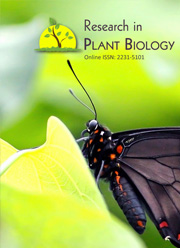SSR markers as tools for screening genotypes of maize (Zea mays L.) for tolerance to drought and Striga hermonthica (Del.) Benth in the Northern Guinea Savanna Zone of Ghana
Keywords:
Maize, drought and striga tolerance, simple sequence repeat markers, quantitative trait loci, guinea savanna, GhanaAbstract
ABSTACT
Resistant or tolerant crop cultivars provide the most economical, practical and sustainable method of control of Striga and drought stresses. However, the development of resistant/tolerant maize cultivars is hampered by the complexity of the environment, the host/parasite interactions, and lack of reliable screening method. The invention of molecular markers to tag gene(s) that confer important traits offer new hope for Striga and drought control. A study was conducted at the Biotechnology laboratory of the Savanna Agricultural Research Institute in Nyankpala, Northern Ghana, to screen six parent and thirty F1 progenies of maize for tolerance to drought and Striga hermonthica using 17 microsatellites. Genomic DNA was extracted with the CTAB method and PCR was performed based on the common method for microsatellite markers. PCR products were separated using 6% polyacrylamide denaturing gel. Frequencies were run to determine the genotypes that produce bands across all or most microsatellite primers.
The results indicated that the F1 hybrids IWD x TAIS03, IWD x GUMA03, DT x KOBN03, TAIS03 x IWD, TAIS03 x DT, TAIS03 x SISF03, SISF03 x TAIS03, SISF03 x GUMA03, GUMA03 x IWD, GUMA03 x DT and GUMA03 x KOBN03 contained the quantitative traits responsible for both drought and Striga hermonthica tolerance. The parental lines DT-STR-W-C2, TAIS03 and IDW-C3-SYN-F2, and F1 hybrid populations IWD x TAIS03, IWD x GUMA03, DT x KOBN03, TAIS03 x IWD, TAIS03 x DT, TAIS03 x SISF03, TAIS03 x KOBN03, SISF03 x DT, SISF03 x TAIS03, SISF03 x GUMA03, GUMA03 x IWD, GUMA03 x DT, GUMA03 x SISF03, GUMA03 x KOBN03 and KOBN03 x IWD contained the quantitative traits responsible for Striga hermonthica tolerance. The study revealed that the parent populations IDW-C3-SYN-F2, TAIS03, GUMA03-OB and KOBN03-OB, and F1 hybrid populations IWD x TAIS03, IWD x GUMA03, IWD x KOBN03, DT x TAIS03, DT x SISF03, DT x KOBN03, TAIS03 x IWD, TAIS03 x DT, TAIS03 x SISF03, SISF03 x TAIS03, SISF03 x GUMA03, SISF03 x KOBN03, GUMA03 x IWD, GUMA03 x DT and GUMA03 x KOBN03 showed bands across nine drought-linked SSR markers, and therefore, contain the quantitative traits responsible for drought tolerance.
The study led to identification of informative SSR markers, such as Phi074, Nc005, Phi015, Phi061 and Phi055, which significantly contributed to the differentiation of Striga tolerant and susceptible genotypes. Identification of informative SSR markers (P-umc1542, P-bnlg1429, P-umc1566, P-umc2189, P-umc2225, P-umc2226, P-bnlg1014, P-bnlg1124 and P-umc1292) which significantly contributed to the differentiation of drought tolerant and susceptible genotypes was also made.



 .
. 